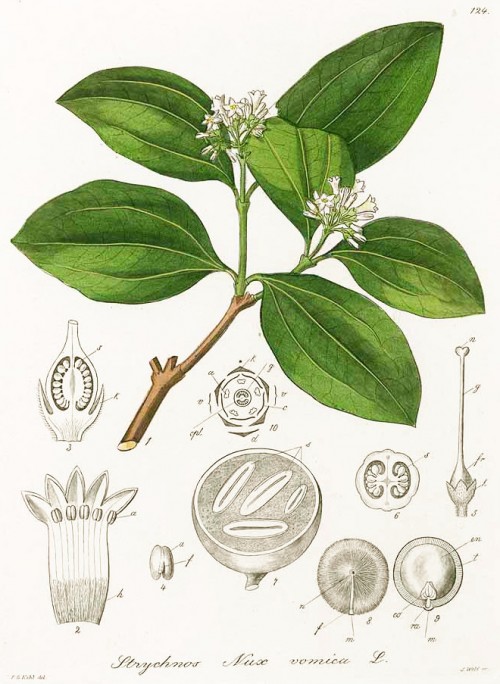Strychnos nux-vomica L. - Loganiaceae - nux-vomica, strychninetree, Brechnussbaum, Strychninbaum
Evergreen shrub or tree, up to 25m high, native to India, Sri Lanka, to Vietnam and Malaysia, also cultivated throughout tropical Asia; leaves broad-ovate, glabrous, entire; flowers salverformed with long corolla-tube, white to greenish-white, calyx 5-lobed; fruit a orange-red berry with from 3 to 5 seeds in a bitter pulp; seeds orbicular to elliptic, 2-4 cm wide, greyish yellow to greyish green.
http://www.efloras.org/florataxon.aspx?flora_id=2&taxon_id=210002121
In earlier times, preparations from the seeds were prescribed for weakness, cardiovascular disorders and as appetizer. Due to toxicity, those drugs have disappeared completely. The seeds are still the starting material for the production of strychnine.
http://de.wikipedia.org/wiki/Gew%C3%B6hnliche_Brechnuss
„The seeds contain approximately 1.5% strychnine, and the dried blossoms contain 1.0%. However, the tree's bark also contains brucine and other poisonous compounds… Strychnine is a deadly poison with a lethal dose to humans of about 30 to 120 mg… The properties of Nux Vomica are those of the alkaloid strychnine… The most direct symptom caused by strychnine is violent convulsions due to a simultaneous stimulation of the motor or sensory ganglia of the spinal cord. During the convulsions there is a rise in blood pressure. Brucine closely resembles strychnine in its action, but is slightly less poisonous, as it only causes paralysis of the peripheral motor nerves… Strychnos nux-vomica is also used in homeopathy.“
http://en.wikipedia.org/wiki/Strychnos_nux-vomica
Small doses of strychnine improve vision (visual acuity, field of vision) but do not improve hearing (however spoken words may be distinguished better against the background).
[The effect of strychnine on visual acuity., Oskarsson, V., Acta pharmacologica et toxicologica, Vol.19(1), 1962, 16-22]
Strychnine is a competitive antagonist at glycine-gated Chloride channels and also a potent competitive antagonist of ACh at neuronal α7 nAChRs and a noncompetitive antagonist at the α4β2 nAChR.
[The effects of strychnine on the inhibition of interneurons by glycine and γ-aminobutyric acid., Davidoff, R.A., Aprison, M.H., Werman, R., International journal of neuropharmacology, Vol.8(2), 1969, 191-194]
[Strychnine: a potent competitive antagonist of α-bungarotoxin-sensitive nicotinic acetylcholine receptors in rat hippocampal neurons., Matsubayashi, H., Alkondon, M., Pereira, E.F., Swanson, K.L., Albuquerque, E. X., Journal of pharmacology and experimental therapeutics, Vol.284(3), 1998, 904-913]
„Almost all parts of S. nux-vomica seem to have been used for one medical purpose or another. The dried ripe seeds called nux vomica as a traditional folk medicine are employed widely in China for the treatments of rheumatoid arthritis, swelling pain, trauma, bone fracture, facial nerve paralysis, myasthenia gravis, and poliomyelitis sequela. Nux vomica contains numerous monomeric bisindole alkaloids in which strychnine and brucine are the dominating.“
[Two new bisindole alkaloids from the seeds of Strychnos nux-vomica., Yang, G.M., Tu, X., Liu, L.J., Pan, Y., Fitoterapia, Vol.81(7), 2010, 932-936]

Kohl, F.G., Die officinellen Pflanzen der Pharmacopoea Germanica, t.124 (1891-1895) [F.G. Kohl]
http://plantgenera.org/species.php?id_species=984786
